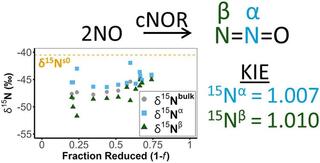Isoptopic fractionation and kinetic isotope effects of a purified bacterial nitric oxide reductase (NOR)
E.D. Rivett et al. "Isoptopic fractionation and kinetic isotope effects of a purified bacterial nitric oxide reductase (NOR)" Biochemistry (2025) [DOI:10.1021/acs.biochem.5c00417]
Nitrous oxide (N2O) is a serious concern due to its role in global warming and ozone destruction. Agricultural practices account for ∼80% of all anthropogenic N2O produced in the US, due in large part to the stimulation of microbial denitrification. Stable isotopes are uniquely suited to examine both microbial N2O sources and the mechanism of N2O biosynthesis through the use of Site Preference (δ15NSP; the difference in δ15N between the central and outer N atoms in N2O) and kinetic isotope effects (KIEs), respectively. Using trace gas isotope ratio mass spectrometry (TG-IRMS), we determined the δ15N, δ15Nα, δ15Nβ, and δ18O of N2O produced by a purified cytochrome c nitric oxide reductase (cNOR) from Paracoccus denitrificans. We also calculated δ15NSP, the KIEs, and associated isotopic enrichment factors (ε) for Nbulk, Nα, and Nβ. A normal isotope effect was observed for bulk 15N, with a KIE value of 1.0086 ± 0.0009 (ε = −8.6 ± 0.9‰). The isotope effects for both 15Nα and 15Nβ were also normal, with position-specific KIEs of 1.0072 ± 0.0010 (ε = −7.2 ± 1.0‰) and 1.0100 ± 0.0010 (ε = −9.9 ± 1.0‰), respectively, and δ15NSP values ranged from 0.5 to 8.7‰ with no significant trend as the reaction proceeded. Values of δ18O increased with N2O production (slope of δ18O against [−f ln f/(1 – f)] = −19.9 ± 1.9‰). We present implications for the mechanism of N2O production from cNOR based on our data.
A Zenodo repository with the data and code used in this study is available at 10.5281/zenodo.17069751.
